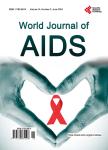Evaluation of Rational Use of Antiretrovirals before the Dolutegravir Transition in Kinshasa, Democratic Republic of Congo
Evaluation of Rational Use of Antiretrovirals before the Dolutegravir Transition in Kinshasa, Democratic Republic of Congo作者机构:“Focus HIV/AIDS” Research Group Kinshasa Democratic Republic of Congo HIV/AIDS Unit Service of Molecular Biology Department of Basic Sciences Faculty of Medicine University of Kinshasa Kinshasa Democratic Republic of Congo Unit of Clinical Pharmacology and Pharmacovigilance Department of Pharmacology and Therapeutics Faculty of Pharmaceutical Sciences University of Kinshasa Kinshasa Democratic Republic of Congo
出 版 物:《World Journal of AIDS》 (艾滋病(英文))
年 卷 期:2021年第11卷第2期
页 面:41-49页
学科分类:1004[医学-公共卫生与预防医学(可授医学、理学学位)] 100401[医学-流行病与卫生统计学] 10[医学]
主 题:Rational Use ARVs Dolutegravir Kinshasa
摘 要:Background: The ultimate goal of AntiRetroViral Treatments (ART) is to achieve complete immune restoration and lasting viral suppression in the infected patient. In order to ensure the efficacy, safety and accessibility of antiretroviral drugs (ARVs), it is recommended that they should be prescribed according to national guidelines;which are evolving with the various recommendations of the World Health Organization (WHO) and the arrival of newer, more effective and safer molecules. Objective: The objective of this study was to assess the rational use of Antiretrovirals in patients treated in Kinshasa before the use of Dolutegravir within the national program in order to assess the correct use of these molecules. Methods: This work is a descriptive cross-sectional study to assess the rational use of first-line ARVs among People Living with HIV (PLHIV) in different Centers of Treatment (ATCs) in Kinshasa before the introduction of Dolutegravir. The records of patients on ARVs were randomly and rationally selected in 12 different ATCs for HIV in Kinshasa according to three centers per district in the period from June to September 2018. Information on use and consumption of ARVs, compliance with guidelines, change of therapeutic combination as well as their reasons were consulted for the present study. Results: 507 files of PLHIV were collected in the various ATCs. 274 (54.1%) were from female patients. The most represented age group was 26 to 35 years with 192 patients (37.9%). The mean duration of first-line treatment for all patients included was 16.30 ± 5.85 months. The most widely used combination of ARVs overall was TDF + 3TC + EFV at 45.4%. 305 (60.2%) PLHIV kept the same first-line treatment molecule throughout the treatment period with an average treatment duration of 12.9 ± 2.77 months. The most common combination found in this population was TDF + 3TC + EFV (69.2%). 202 (39.8%) PLHIV changed



